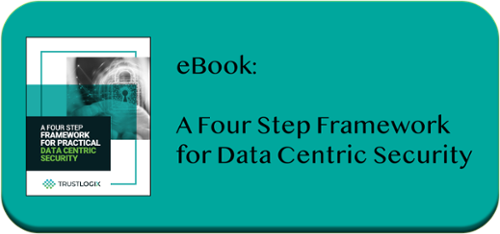Data Lake Security: An Explanatory Guide With Best Practices
Stay in the Know
Subscribe to Our Blog

Data is the "oil" of the century. All data-driven organizations are finding ways to effectively collect, store, analyze, and secure their data.
A data lake allows organizations to house their data and perform analytics in order to gain insights into their customers and their business operations. However, organizations must take measures to secure their data repositories from breaches and cybersecurity threats. They need to move to a Data Centric Security model.
This post will give you insights about data lake security. You'll find out what it entails and how you can ensure that your data is safe.
Here's what you'll get from this article:
- A brief introduction to the concept of a data lake
- The definition of data lake security
- Fundamentals of data lake security
- Best practices for data lake security
What Is a Data Lake?
Data-driven organizations have data of all forms. This includes data from social media, the Internet of Things, web applications, mobile applications, databases, and more. Therefore, data isn't necessarily structured. Rather, various forms of unstructured and semi-structured data are co-located with traditional, structured data. These various types of data need a storage space to live in.
A data lake is essentially a repository that allows organizations to store varied forms of data. A data lake also enables data processing, querying, and analysis through advanced machine learning and data visualization.

A key feature of a data lake—as opposed to a data warehouse—is that there's no need to worry about reformatting the data or defining a data schema in order to store it. Data lakes provide the benefit of storing data in the format in which it was originally produced.
What Is Data Lake Security?
The era of big data has propelled technological advancements. It has given organizations the ability to use data to uncover insights about their customers and therefore grow. Over the years, many organizations have shifted their data lakes to cloud platforms. This has allowed them to effectively manage and store data while saving money on data infrastructure costs.
However, cloud storage and computing environments are more vulnerable to cyberattacks. Moreover, such environments are highly dynamic. They're constantly scaling up to put out new features, applications, and tools and to manage new customers. All this means more data vulnerabilities, which creates a need for data security policies.
Data lake security is a set of practices and procedures to ensure data protection from cyberattacks. A data lake sources data from multiple sources that may contain sensitive information (such as credit card numbers and medical test results), customer data, and so on. These external sources may produce dynamic, real-time data from millions of users and transactions. This situation creates many cybersecurity risks. The following section will give insights into the fundamentals of data lake security and how you can ensure your data is protected in your data lake.
Fundamentals of Data Lake Security
A data lake security system entails four key components: administration, authorization, authentication, and protection of data.
Data Administration
Administration involves overseeing the entire data cycle, resource management, and database design within the data lake. This requires careful planning to create data systems that can enable safe and secure data sharing within and outside an organization's infrastructure.
When an organization creates a data storage infrastructure, its staffers must design each component to ensure it meets security standards. Through data administration, organizations can get a holistic view of who gets access to data, where it's being stored, which applications are producing what type of data, and so on. Moreover, this approach allows the organization to maintain consistent security standards throughout the data lake.
Data Access Control (Data Authorization)
As mentioned earlier, a data lake allows an organization to store data from multiple sources and devices. For this reason, a data lake uses an object storage model instead of a hierarchical file storage model.
An object storage model dumps all unstructured data in one place and doesn't categorize or segment data. This means that access control to each object isn't as well defined. One user may have access to data from multiple sources. Thus, it's crucial to implement data access control and provide access solely to employees who require it. And that means it's necessary to implement a Data Centric security model that gives you fine-grained data access control and data authorization. This ensures tight control over which users and roles are allowed what degree of access down to very granular row and column level specificity.
Data Encryption
Data encryption is a primary security practice that just about all organizations follow. Most cloud platforms provide data encryption services for data lakes. However, it's possible to adopt multilayered data encryption schemes to increase data protection. Also, there are other approaches to data protection, such as tokenization.
 Data Lake Security Best Practices
Data Lake Security Best Practices
Keeping these key data lake security concepts in mind, let's look at a few tips and practices you can follow to ensure data lake security.
Create a Logical Structure
A conventional database storage system has an inherent structure and a predefined data schema. Naturally, this makes it easier to assign access controls. However, data lakes have a looser structure, which makes it challenging to assign access controls.
A good practice is to create a data pipeline with different levels that correspond to data acquisition, processing, analysis, monitoring, and so on. This creates a structure that lets you assign access control and roles to each layer of the data lake. Moreover, it restricts each layer to a limited number of experienced experts.
Practice System Hardening or Cloud Hardening
Whether your data is on-premise or on-cloud, system hardening is crucial to prevent data leakage threats and cyberattacks. Essentially, this practice involves minimizing risks associated with data vulnerabilities by consistently configuring each component of the data lake. For instance, it might involve getting rid of unnecessary applications, restricting access and authorization, and following standard Center for Internet Security (CIS) benchmarks.
It's also crucial to draw a line between operating or managing the data lake and managing the cloud platform. This separation allows you to implement appropriate security measures. For instance, it could involve assigning experienced security professionals to the cloud platform while assigning appropriate roles for administration and management of data lakes.
Audit Your Data
Data auditing is crucial in a data lake because data is pouring in from many sources. Auditing allows you to keep track of the type of data, who has access to it, what recent modifications have been made to the data, and so on. Moreover, some streams of data may contain highly confidential information that require additional security measures. In such cases, auditing can be extremely beneficial.

Enhance Your Security
How can you strengthen data lake security? Much of this is common sense.
- Regularly back up data, of course.
- Limit modification access to a selected few.
- Perform regular audits and IT checks.
- Monitor user data access patterns and right size access controls.
- Streamline the process using a Framework for Data-Centric Security
Conclusion and Learning More
Securing a data lake is a complex task! But properly structuring and organizing your data can help reduce the complexity. Moreover, choosing the right tools and platforms to secure your organization can help reduce data vulnerabilities and compliance violations.
TrustLogix offers a unified approach to ensure data security across all components of the data lake. Our Data Security Governance platform provides total visibility into data access risks and enforces granular access controls for the entire data lifecycle of the data lake—from ingestion to usage. Check out our demo to learn more and subscribe to our blog to get notified about new posts.


